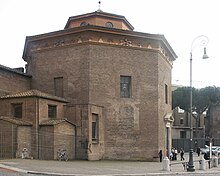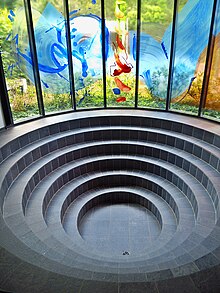Baptistery

Octagonal Baptistery of the Lateran in Rome from the 4th century
|
Baptistery (from Greek βαπτίζω baptízō "submerge, baptize", βάπτισμα báptisma "immersion, ablution, baptism ") designates a Christian baptistery in today's usage.
About history
Originally, the baptistery meant the basin of a Roman cold water bath within a thermal bath . The name was initially adopted by the Christians for the baptismal font , and later also for the baptistery itself.
In the early phase of Christianity , baptisteries were usually built as special structures directly next to a church , often connected to it. They were often designed as a central building with a square, round, polygonal or, especially in the east , a cross-shaped floor plan with a large baptismal font in the middle. Occasionally the baptismal font was surrounded by a wreath of columns over which there was a canopy or ciborium . Since late antiquity there could be several baptisteries in one place.
Since early Christian times, the purpose of a separate baptistery outside the church has been that no unbaptized person was allowed to enter the sacred space of the church. The baptism of adults was also performed on completely unclothed people to be baptized, who were not allowed to go into the actual church in their nakedness.
Outside of Italy, the baptistery lost its independence in the 8th century (789) when it was ordered that children should be baptized in the first year and therefore the baptisms moved to the actual church. Only Italy partially retained the tradition of separate baptisteries.
We know from early Christian sources that baptism was performed either by complete immersion (mainly towards the east) or by pouring the person to be baptized while standing in the water. The baptisteries were also often relatively large because baptisms only took place on certain days of the church year , especially on Easter vigil . When the number of infant baptisms increased immediately after birth from the Carolingian period onwards, the baptisteries, which were independently established by the church, became rarer, as small baptismal fonts were now sufficient. Old baptisteries often survived as churches consecrated to John the Baptist after they had no liturgical function.
About number symbolism and other meanings
The floor plan of the baptisteries is often octagonal , i.e. octagonal. Eight generally means a new beginning and resurrection : On the first day of the week (Sunday), Christ rose from the dead, and so the originally first day of creation was regarded as the eighth day and day of the new creation. Eight days later, Jesus appeared again to the disciples, eight people survived in Noah's ark.
The Gregorian music of the Salier period also has 8 tones.
The octagon also mediates geometrically between the square as the symbol of matter and the circle as the symbol of the spirit, and it stands between this world and the hereafter, corresponding to the connection between earthly and heavenly in baptism.
There is also the round shape . Symbolically, baptism means death and resurrection: death, insofar as the person to be baptized is submerged under water and symbolically the sinful old person dies and is born to new, eternal life ( Rom. 6 : 3-5 EU ). Therefore, Christian baptisteries often adopted the round shape of the ancient Roman mausoleum , which was round in its traditional shape. The rotunda above the tomb of Jesus in Jerusalem from the 4th century is also a rotunda to this day.
The historical model for this design are on the one hand the Etruscan tombs of prehistoric times, which were the inspiration for the imperial tombs, and the anastasis in Jerusalem, on the other hand the domed caldarium , i.e. the hot water room of an ancient thermal bath.
Well-known baptisteries
The oldest preserved baptisteries date from the 4th century. One of the oldest is the Lateran Baptistery in Rome (see picture).
In the 5th century the famous baptismal churches were built in Ravenna: the baptistery of the Orthodox (baptistery of the cathedral) and around 500 the baptistery of the Arians with its magnificent mosaics .
The octagonal baptisteries of Portbail in the Normandy and Fréjus region are also said to date from this period.
The Saint-Jean Baptistery in Poitiers is one of the oldest Christian buildings in France.
The Riva San Vitale baptistery in the canton of Ticino in Switzerland dates from the 5th century.
The Baptistery of San Giovanni in Florence was built based on the ancient model in the Proto-Renaissance style .
The Baptistery of San Giovanni in Parma is one of the most important medieval buildings in Italy at the transition from the Romanesque to the Gothic style.
In Germany there are early Christian baptisteries in Cologne and Boppard from the 6th century .
The Baptistery in Pisa is the largest baptistery in Christian history and part of the UNESCO World Heritage Site.
The Baptistery of Torre de Palma in Portugal is the largest in the Iberian Peninsula .
photos
Baptistery of a Roman basilica in Stobi , Macedonia. (4th century)
Baptistery in Fréjus Cathedral (5th century)
Baptistery of St. Mary's Church in Ephesus (6th century)
Baptistery of San Giovanni in Florence (11th century)
Baptistery in Parma (13th century)
Cathedral and Baptistery in Padua (13th century)
Individual evidence
- ^ André Corboz, Henri Stierlin (Ed.): Early Middle Ages (= Architecture of the World. Vol. 14). Taschen, Cologne 1994, ISBN 3-8228-9534-2 , p. 130.
- ^ Nikolaus Pevsner : European architecture. From the beginning to the present. 3. Edition. Prestel, Munich 1973, ISBN 3-7913-0137-3 , p. 19.
literature
- Romuald Bauerreiß : Fons sacer. Studies on the history of the early medieval baptistery in the German-speaking area (= treatises of the Bavarian Benedictine Academy . Vol. 6, ISSN 0408-7097 ). Filser, Munich-Pasing 1949.
- Ulrich Krings , Rainer Will (ed.): The baptistery at the cathedral. Cologne's first place of baptism. Greven, Cologne 2009, ISBN 978-3-7743-0423-9 .
- August Mau : Baptistery . In: Paulys Realencyclopadie der classischen Antiquity Science (RE). Volume II, 2, Stuttgart 1896, Col. 2851.
- Sebastian Ristow : Early Christian Baptisteries (= yearbook for antiquity and Christianity. Supplementary volume 27). Aschendorff, Münster 1998, ISBN 3-402-08111-3 .
Web links
- Interactive map of Early Christian Baptisteries - founded by S. Ristow, Early Christian Baptisteries (1998)












